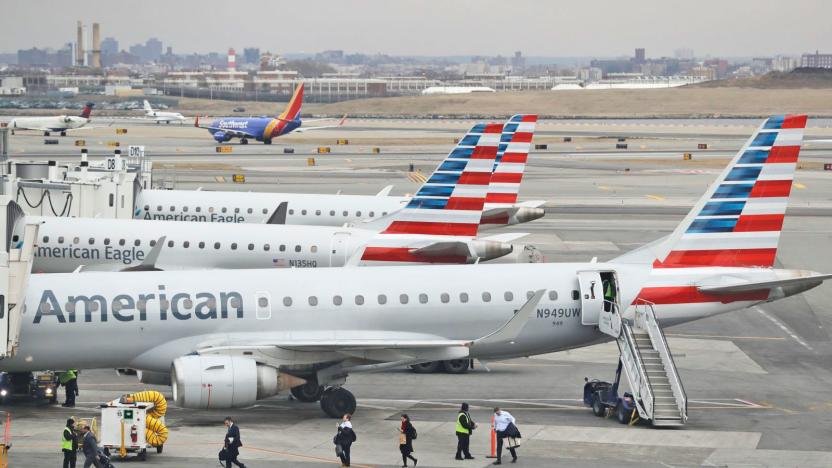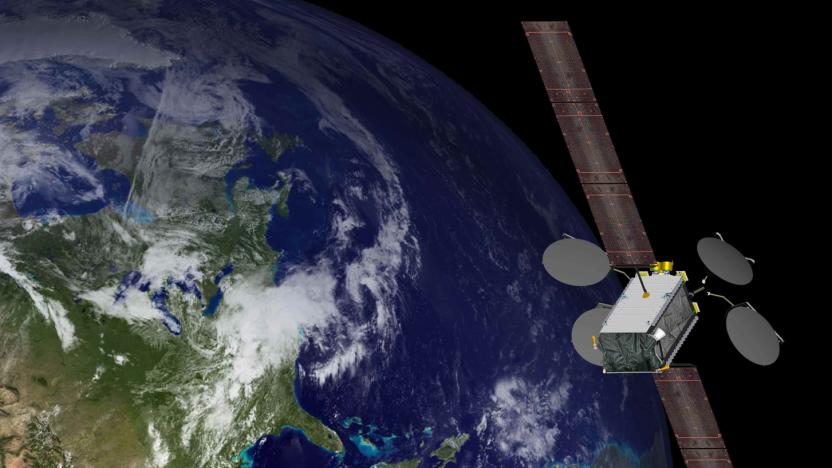ku band
Latest

American Airlines offers satellite WiFi to its entire mainline fleet
If you're relying on American Airlines for a summer trip, there's a good chance you'll have internet access most of the way. The company has finished deploying satellite-based internet access to the fleet of 700-plus narrowbody aircraft that mainly handle its domestic routes. Depending on where you're going, you'll have either Gogo 2Ku or ViaSat Ka connections providing speedier, more consistent WiFi than the ground solutions of old. American deployed satellite broadband to its widebody aircraft roughly a year earlier.

World's first all-electric propulsion satellite begins operations
Boeing has announced that the first satellite using fully-electric propulsion has begun operating. Dubbed the ABS-3A, this 4,300-pound telecommunications satellite will provide C- and Ku-band service to South America, the Middle East and Africa. Unlike, well most every other satellite in orbit, the ABS-3A doesn't rely on tanks of inert gas for propulsion and orbit maintenance. Instead it relies on the Xenon Ion Propulsion System (XIPS) which employs a magnetic field to push ions around and generate thrust. The satellite is expected to use just 11 pounds of Xenon annually over the course of its 15 year operational life span -- that's a tenth the amount of propellent that a conventional satellite would require.

Virgin's new in-flight WiFi is strong enough to stream video
Virgin America has announced that it's teaming up with satellite internet company ViaSat to provide the fastest in-flight WiFi of any commercial carrier. The new system uses a hybrid Ku-/Ka-band receiver to deliver an internet pipeline eight to 10 times faster than anything else on the market. The Ka-band alone offers a whopping 140 gigabits-per-second throughput. It's being installed on the company's new fleet of A320 airliners and will be put into service on Hawaii-bound routes starting next year. That alone is a big accomplishment as the rest of the airline's fleet have to rely on ground-based WiFi connections, which don't work over the ocean's expanse. Virgin touts that this in-flight connection will be equivalent to an average home broadband link and users are expected to use it as such, streaming videos, watching the carrier's 18 channels of DishNetwork and surfing the internet with abandon -- just at 35,000 feet.

SpaceX wants to launch internet-beaming satellites
Google's Project Loon and Facebook's internet drones could soon see added competition from SpaceX. The Elon Musk-owned rocket company has just petitioned the FCC for permission to launch a pair of experimental, identical Ku-band downlink satellites -- the first pair of potentially four. Should the FCC grant SpaceX's application, Time reports that the satellites will likely launch from Vandenberg Air Force Base. Once they reach an orbital altitude of 625 km, they'll beam down broadband internet speeds to three receivers located in Redmond, Washington; Fremont and Hawthorne, California. The satellites are each rated for a 12-month operational lifespan. There's no word yet on when this technology will be available to consumers.

Surfing with GTO, the very promising future of Gogo in-flight WiFi
Let's face it: with few exceptions, in-flight WiFi still sucks. ViaSat's solution available on a few United and JetBlue planes is a step in the right direction, but even that product is inconsistent at times, if you're even lucky enough to end up on an equipped flight. The vast majority of in-flight internet is supplied by Gogo, utilizing an air-to-ground infrastructure that's similar to the cell phone networks that we all love to hate. But the company's next-generation solution, called GTO (Ground to Orbit), represents a tremendous improvement across the board.

United becomes first US airline to offer overseas WiFi with satellite-equipped 747
Lufthansa's been pulling (relatively) speedy Ku-band satellite internet from the heavens for a bit over two years, but now trans-Atlantic and trans-Pacific WiFi has finally made its way to a US-based carrier. United, the first US airline to fly the Dreamliner, announced today that a Boeing 747-400 is currently flying around the globe with a constant connection, letting passengers hop online during any portion of the flight -- taxi, takeoff and landing being are a few obvious exceptions, but there's no requirement that the aircraft operate within range of air-to-ground transmitters, a la Gogo. The installed equipment, manufactured by Panasonic, will provide two tiers of service: Standard, which will range in price from $4 to $15, and a speedier Accelerated flavor, with pricing between $6 and $20. The service, which has also been installed on a pair of regional Airbus A319s, isn't as speedy as ViaSat's future Ka-band offering, but it's a step above what's currently on board. United also announced plans to bring WiFi to its A320, along with Boeing 737, 757, 767, 777 and 787 aircraft -- the airline expects installation to be completed on 300 planes by the end of this year. Still missing on many United flights, however, are power jacks -- it's difficult to take advantage of in-flight WiFi if your laptop is dead. Update: Satellite WiFi historians may be familiar with Boeing's failed Connexion service, which promised a similar solution but dissolved prematurely in late 2006. United's implementation is the first of its kind for a US carrier.

JetBlue Ka-band high-speed internet now arriving in early 2013, eight times faster than the competition
JetBlue Airways' high-speed wireless initiative is being held in a flight pattern until "early 2013," apparently. The company announced as much in a detailed blog post this afternoon, which also compared speeds of its forthcoming in-plane high-speed internet to the competition -- JetBlue's Ka-band operates roughly eight times faster than the Ku-band competition, and over nine times faster than ATG. Moreover, Ka-band can scale to a full plane of passengers, meaning everyone gets the "at-home experience" they'd like regardless of how many folks are signed on. As previously noted, the "basic Wi-Fi" service with JetBlue will cost nothing -- which sounds to us like there are plans to reveal a more expensive tier (or tiers) in the near future. But then again, we really like free things.

Delta expanding Gogo in-flight WiFi to select international flights beginning in 2013
Delta Airlines isn't a stranger to offering WiFi on many of its domestic US flights, but using Gogo's air-to-ground connection setup has essentially kept it from taking off over the seas. That's all set to change come 2013, however, as 150 of Delta's long-haul aircraft will make use of all those high-bandwidth Ku-band capacity satellites that Gogo has been acquiring over the past few months. The updated setup will ensure that you can update your Facebook status over the likes of the Atlantic, but it won't be fully rolled out until about 2015. By that time, the airline estimates it'll be operating around 1,000 Gogo-equipped aircraft worldwide -- not too shabby. If anything, the wait to hit 10,000 feet is surely going be more interesting for all the international work-a-holics out there. Hit up the press release after the break for more details in the meantime.

Gogo spreads its in-flight WiFi wings further with SES satellite deal
Rejoice frequent-flying lovers of the Interwebs. All systems continue to be a go for in-flight WiFi provider Gogo as the company inks a deal with yet another satellite operator. A new agreement with global satellite company SES puts Gogo closer to providing seamless WiFi for passengers on intercontinental flights that use its service -- SES' coverage area includes the United States, Europe and the Atlantic Ocean region. The agreement comes along the heels of deals signed by Gogo with Inmarsat for Ka-band frequency service and AeroSat to use its HR6400 satellite communication system for Ku-band connections. The company says Ku-band service could be available on commercial flights using Gogo's network as early as the end of this year, providing more options for, say, Airtime video chat hijinks. As long as Internet access prevents bored kids from kicking the back of our airline seats, then it's all good.

Gogo and AeroSat get friendly on Ku-band, bring international in-flight WiFi closer
Gogo has a virtual lock on in-flight WiFi for the US, but most of us forget that everything goes dark the moment you decide to cross the border. The company already has a deal with Inmarsat for Ka-band Internet connections, and now it's partnering up with AeroSat to bring Ku-band satellite access. The tie-in will let Gogo offer precious relief from tedium on international flights, whether it's a modest hop to the Great White North or an hours-long trip across the ocean. Gogo considers the deal an interim step until Inmarsat's technology is ready, making for much quicker availability than if it had just waited until it could use Ka-band: Ku-band satellite linkups should be on airliners as soon as the end of 2012, while Ka-band won't even show its face until at least late 2014. It's unknown what kind of premium we'll pay over the $13 maximum Gogo normally charges, but if AeroSat lets us squeak in a few more Twitter updates on our way home from Barcelona, it'll be worthwhile.

In-flight WiFi coming to 300 United and Continental aircraft beginning in mid-2012, entire fleet covered by 2015
Planning to fly on United or Continental at any point over the next few years? Then it looks like your odds of having in-flight WiFi will be getting increasingly better. United Continental Holdings announced today that it's signed an agreement with Panasonic Avionics Corporation to bring satellite-based WiFi connectivity to more than 300 of its aircraft beginning in mid-2012. Those aircraft will include Airbus 319 and 320 and Boeing 747, 757, 767, 777 and 787, and the company says it expects its entire mainline fleet to be covered by 2015. No specific word on any additional content or services that will come with it (or a cost, for that matter), but the company promises that the system will "enable wireless streaming of video content."

Intellian delivers first DirecTV Ka-band capable marine satellite TV systems
Hitting the high seas (or the slightly lower lakes and rivers, whatever works) shouldn't keep you from all those new HDTV channels DirecTV's been adding, requiring Intellian Technologies' new k4 and k6, the first marine satellite systems that will tune into Ka-band broadcasts. With their 17.7- and 23.6-inch antennas packed into all-in-one domes they should be able to track and switch among Ka- and older Ku-band satellites as necessary, even on a fast moving boat. We're sure you've already switched to MPEG-4 compatible hardware at home, the dinghy is next.

DISH Network's AMC-14 satellite set for March 15 launch
Guess what, DirecTV subscribers? Your satellite provider isn't the only one launching a new bird into orbit next month. On March 15, the AMERICOM-14 (AMC-14) will blast off from Kazakhstan and begin its mission of providing DISH Network with "the bandwidth resources needed to increase the number of high-definition and other services offered by EchoStar nationwide." Of course, we've no idea how quickly customers will begin reaping the benefits from yet another sat in the sky, but we'll be a whole lot closer to knowing when this thing (hopefully) departs the atmosphere as planned.[Via SatelliteGuys, thanks Joe][Image courtesy of LaunchPhotography]








